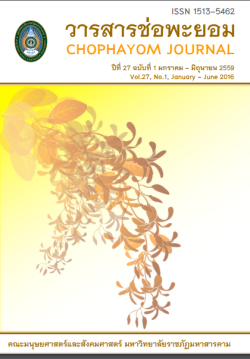การพัฒนาตัวชี้วัดและตัวแบบคุณภาพการบริการในระดับอำเภอ : กรณีศึกษาหน่วยงานภาครัฐในจังหวัดมหาสารคาม Development of Indicators and Models of Service Quality at District Level : A Case Study of Government Agencies in Mahasarakham Province
Abstract
บทคัดย่อ
งานวิจัยในครั้งนี้มีวัตถุประสงค์เพื่อศึกษาระดับคุณภาพการบริการ ปัจจัยที่มีผลต่อคุณภาพการบริการความสัมพันธ์ระหว่างหน่วยงานภาครัฐกับระดับคุณภาพการบริการ และปัจจัยที่มีผลต่อระดับคุณภาพการบริการการสร้างตัวแบบพยากรณ์ การวิเคราะห์องค์ประกอบของตัวชี้วัด และหาแนวทางพัฒนาคุณภาพการบริการ
วิธีวิจัยใช้วิธีผสม (mixed method) ประกอบด้วย 1) การวิจัยสำรวจสุ่มตัวอย่าง (sampling survey research) โดยสุ่มตัวอย่างแบบหลายขั้นตอน (multi-stages sampling) จากกลุ่มตัวอย่างใน 6 หน่วยงานใน 7 อำเภอในจังหวัดมหาสารคาม รวม 630 คน เครื่องมือในการวิจัยเป็นแบบสอบถามแบบประเมินค่าและวิเคราะห์ข้อมูล
โดยใช้สถิติความถี่ ร้อยละ ค่าเฉลี่ย ส่วนเบี่ยงเบนมาตรฐาน การวิเคราะห์ความแปรปรวนทางเดียว การวิเคราะห์ถดถอยพหุคูณแบบขั้นตอน และการวิเคราะห์องค์ประกอบเชิงยืนยัน ด้านความตรงตามเนื้อหาของแบบสอบถามผ่านการประเมินจากคณะผู้เชี่ยวชาญจำนวน 10 คน ส่วนความเชื่อมั่นของระดับคุณภาพการบริการวัดจากค่าสหสัมพันธ์อัลฟาของครอนบาค (Cronbach’s alpha coefficient) ได้ .945 และ 2) กลุ่มสนทนา (focus group)ซึ่งจัดหลังจากการวิจัยสำรวจโดยมีผู้เข้าร่วมทั้งหมด 16 คน และนำข้อมูลที่ได้มาวิเคราะห์ด้วยการวิเคราะห์เนื้อหา
ผลการวิจัยสำรวจ พบว่า หน่วยงานมีคุณภาพการบริการสูงทุกหน่วย หน่วยที่มีคะแนนสูงสุด คือ สำนักงานปศุสัตว์อำเภอ และต่ำสุด คือ สำนักงานสาธารณสุขอำเภอ และแต่ละหน่วยงานมีจุดเด่นและจุดด้อย รวมทั้งมีปัญหาในการให้บริการแตกต่างกัน ส่วนระดับปัจจัยที่มีผลต่อคุณภาพการบริการอยู่ระดับปานกลางถึงมาก ทั้งยังพบว่าหน่วยงานมีความสัมพันธ์กับระดับคุณภาพการบริการ การตรวจสอบระบบบริการ กลยุทธ์การปรับปรุงคุณภาพการบริการและอุปสรรคต่อการพัฒนาคุณภาพการบริการ ส่วนตัวแบบพยากรณ์ พบว่า ตัวแปรที่มีผลต่อคุณภาพการบริการมี 4 ตัว ได้แก่ 1) วัฒนธรรมการบริการ 2) การตรวจสอบระบบบริการ 3) อุปสรรคต่อการพัฒนาคุณภาพการบริการ และ 4) กลยุทธ์การปรับปรุงคุณภาพการบริการ จากการวิเคราะห์องค์ประกอบ พบว่า ตัวชี้วัดคุณภาพการบริการที่กลมกลืนกับข้อมูลเชิงประจักษ์ ได้แก่ 1) การสื่อสาร 2) ความน่าเชื่อถือ 3) มารยาท) และ 4) ความสามารถ
ABSTRACT
This research aimed to investigate level of service quality, factors affecting service quality, relationship between government agencies and service quality, and factors affecting level of service quality. Moreover, this paper also built a forecasting model, analyzed elements of indicators, and provided resolutions to improve service quality. The study was conducted using mixed method as follows: (1) sampling survey research applying multi-stages sampling to select 630 samples from 6 government agencies in 7 districts in Mahasarakham province. The research instrument was a rating scale questionnaire and the survey data were analyzed using by frequency, percentage, mean, standard deviation, one way ANOVA, stepwise multiple regression and confirmatory factor analysis. The assessment of contents validity of questionnaire undertaken by a panel of 10 experts. As for reliability easurement of the service quality level, Cronbach’s alpha coefficient was .945, and (2) focus group was held after survey research from 16 participants and its data was analyzed utilizing content analysis.
The results found that the service quality of all government agencies was at high level. It could be said that District Livestock Office had the highest service quality while District Public Health Office had the lowest service quality. Each government agency had both advantages and disadvantages as well as different problems to provide the service. The factors affected the service quality at moderate to high level. Besides, the government agencies had the relationship with the service quality, inspection of service system, strategies on service quality improvement,and obstacles on service quality development. According to the forecasting model, there were 4 elements influencing the service quality: (1) culture of service, (2) inspection of service system, (3) obstacles on service quality development, and (4) strategies on service quality improvement. The analysis of elements also indicated that there were several indicators of service quality which were concordant with empirical data including (1) communication, (2) credibility, (3) courtesy, and (4) competence.






